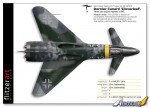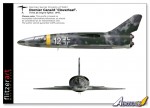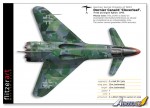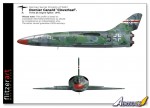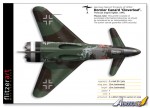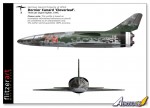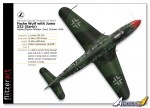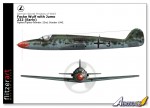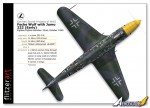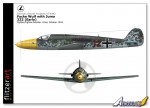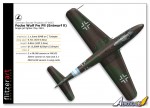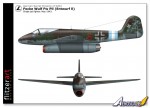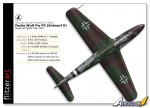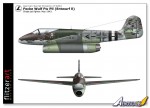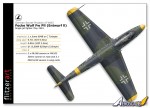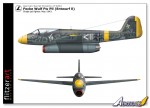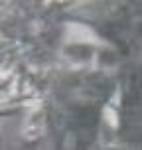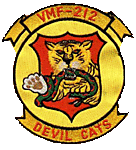1⁄1Luftwaffe Projects - Volume 9
10
Comments
Dornier Canard ‘Cloverleaf’. Advanced Fast Pursuit Fighter
I have been intrigued by this advanced Dornier project for some time, but due to limited information and references I have shied away from doing a profile until now. I have only ever seen a small paragraph or two of text and one simple three-quarter image showing the position of the 3 engines. But relying on some great help from members of the Secret Projects site, I’ve been able to produce something that looks pretty close.In spite of being fully occupied with a huge workload the Dornier design office began studies for a fast multiple-jet pursuit fighter in 1944. The layout adopted forward canard and swept main wings with the pilot housed in the extreme fuselage nose. The three engines were arranged in a ‘cloverleaf’ formation, with two side by side above with the third being centered below them. These were fed by air ducts and wing boundary layer suction slots. It would been possible to shut down two of the three engines without undue airflow drag therefore greatly increasing its tactical range. The design study was cancelled due to problems with the Heinkel Hirth powerplants.
Focke Wulf 222 Fighter (Early design)
In 1942 the RLM gave the final approval for the proposed Jumo 222 bomber engine. Dipl-Ing Tank immediately explored how this large engine might be used to power a heavy fighter/ground attack aircraft. Using knowledge gained from the experimental 222 engined Fw 190, the design team produced a completely new concept.The powerplant was positioned amidships powering a 4 blade propeller via drive shafts channeled through the cockpit in a similar way to the USA Bell’s P39 Aircobra and P39 Kingcobra. No further work was carried out when the Jumo 222 was shelved a year later. Ironically work on the Jumo 222 engine was resurrected later in the war.
Focke Wulf Pll jet Fighter
This was Kurt Tank’s second design for a single-jet engine, single-seat fighter, and was submitted 9th,June,1943. The wing was mounted mid-fuselage and had a slight sweep on the leading edge and straight trailing edges. A Jumo 004B turbojet was hung beneath the fuselage for ease of access and maintenance and also because of fears of then operational problems associated with mounting the jet engine on top of the fuselage. Unfortunately the RLM considered there were some greater disadvantages to this design, such as the nose wheel blocking the intake on takeoff and landing, possibly allowing foreign matter to be sucked into the intake as it was so close behind it. There was also the fear of the destruction of the jet engine in case of a belly landing although the Me262 seemed to cope well enough.The pilot sat in an armoured cockpit. Armament was to be two MK 108 or MK 103 30mm cannon in the fuselage nose and two MG 151/20 20mm cannon in the wing roots. Opinion is that other than the intake/nose wheel positions it probably would have performed very well in its intended role.
Comments
Cheers Peter
My pleasure. It's really impressive to see how your artwork increases steadily in sophistication with each new volume.
I'm intrigued by the mysterious Wn 19 - it does just look like someone's simplistic sketch of a '109, so it'll be really interesting to see if any firm information ever surfaces...
All the best
Rowan
OCT 09, 2012 - 08:08 AM
Many thanks JPTRR, nice to see you are still around site.
Rowan, should I learn of anything more on the Wn 19, I'll definitely share any findings. I'm sure there's a lot more to be discovered.
P
OCT 11, 2012 - 06:55 AM
Great work as always Peter, It's always nice to see a different take on the colour schemes and / or just to see these projects in colour. I do like the little Skoda 257 and the Fw-222.004, and then you tease with the last line 'Italian' for Vol.10, I can't wait, Re.2007 perhaps
OCT 11, 2012 - 07:45 AM
Wonderful stuff, as usual, Pater
Do you have any profiles of aircraft that saw combat during WWII (Spit, 109 etc)?
OCT 11, 2012 - 04:17 PM
Very interesting stuff, I hope to see more in the future.
Thanks for all the effort you put into this.
OCT 15, 2012 - 07:14 AM
Many thanks, I'm just enjoying myself really.
Luciano, Re2007....we'll see .
Mal.
I did do some profiles of some British aircraft that saw actual combat. It was years ago now but they were published on site.
I've not done any more since, apart from some early jets, as there are so many accomplished artists out there that cover these already, I've tended to seek areas that are less well populated if you see what I mean.
Tah muchly
Peter
OCT 19, 2012 - 03:33 AM
"....it was the first jet combat aircraft, the first twin-jet aircraft and the first jet aircraft to go beyond mock-up stage." not so "first" considering and other constructors of jet airplanes before 1941
DEC 26, 2018 - 05:17 AM
Copyright ©2021 by Peter Allen. Images also by copyright holder unless otherwise noted. The views and opinions expressed herein are solely the views and opinions of the authors and/or contributors to this Web site and do not necessarily represent the views and/or opinions of AeroScale, KitMaker Network, or Silver Star Enterrpises. Images also by copyright holder unless otherwise noted. Opinions expressed are those of the author(s) and not necessarily those of AeroScale. All rights reserved. Originally published on: 2012-10-06 00:00:00. Unique Reads: 15547




